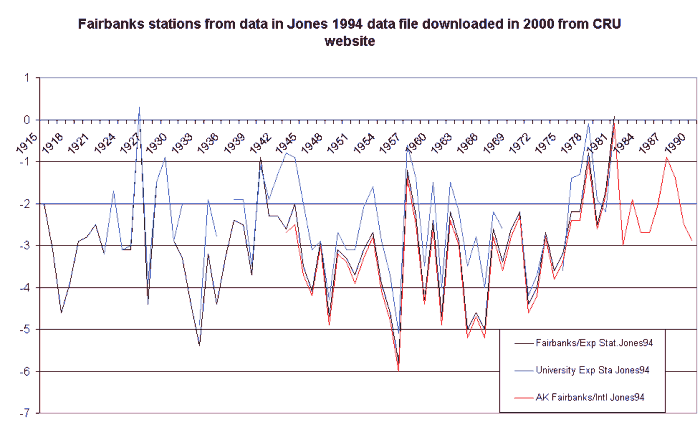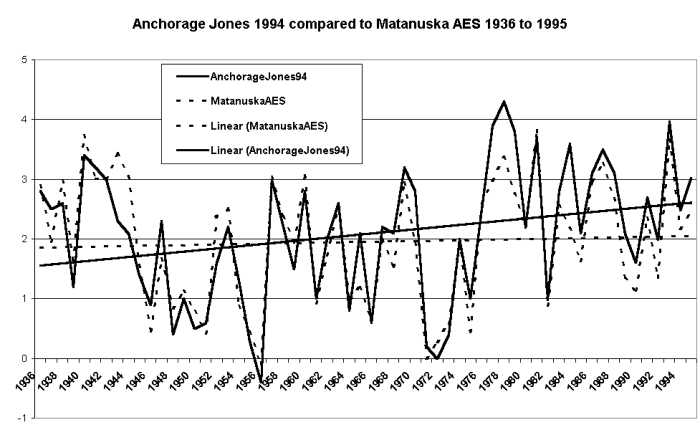Fairbanks Grid Cell,
Alaska
Scientists at the University of Alaska at Fairbanks have recently published
a paper describing the Fairbanks urban heat island. An abstract is available
from the internet, see bottom of page. This seems like a good opportunity
to look at publicly available temperature data for Fairbanks and see how
the Jones / IPCC data corrects for this now documented UHI warming..
In the Jones et al 1985 hard copy documentation (see ref. below), station
lists 702617 FAIRBANKS/EXP STAT. with data from 1915 to 1981 and 701928
UNIVERSITY EXP STA with data from 1922 to 1981, neither of which
were corrected. Both stations are listed as 147.9 degrees West but
UNIVERSITY EXP STA is 64.9 degrees North and FAIRBANKS/EXP STAT
is 64.8 degrees North.
In the Jones 1994 digital data file, 702610 AK FAIRBANKS/INTL
is added with data from 1942 to 1990 located at the same lat
/ long as FAIRBANKS/EXP STAT.
In the 1996 update digital file there are no Fairbanks stations reporting.
The graphic shows the three stations, the two long term stations have
little trend but AK FAIRBANKS/INTL has a warming trend of about 1.8
degrees mainly due to the data only being available from 1942. What
could be the point of this "doubling up" of the Fairbanks warming trend
by the addition of AK Fairbanks/Intl in the 1994 update ?

Current Debate:
In response to an emailed comment to Timo Hameranta from Dr Jones,
"We don't use the Fairbanks data.."
I posted the following on the Climate Sceptics website 19 September
2002.
Dear Timo,
Thank you again for your efforts running the Climate Sceptics discussion
group which leads to so much interesting email. Re your mail of 13
September.
I note with interest a comment to you from Phil Jones "We don't
use the Fairbanks data.." Not sure as to exact meaning of this, maybe
it translates as "We don't use the Fairbanks data - NOW.."
Because his team used two Fairbanks stations in their late 80's global
compilation and 1991 update,
701928 UNIVERSITY EXP STA
702617 FAIRBANKS/EXP STAT.
then added a third station for the 1994 update making,
701928 UNIVERSITY EXP STA
702610 AK FAIRBANKS/INTL
702617 FAIRBANKS/EXP STAT.
Global policy makers went to the Rio Earth Summit in 1992 with the
benefit of the first version Fairbanks data and to Kyoto with the 1994
update.
Does this mean that Phil Jones now accepts that Fairbanks data is UHI
affected ?
Is he still using Anchorage data ?
It would be very helpful to have a full list of stations that
Phil Jones no longer uses with date that usage ceased.
Phil talks about a new study due soon. The documentation for this needs
to be vastly improved over earlier efforts. We should be able to access
grid cell trends maybe by a clikkable map a la the GISS site. All station
data contributing to those trends should be downloadable, updated to recent
months.
Best wishes,
Warwick Hughes
In email correspondence last week Dr Jones replied
on 20 September.
Timo, Warrick,
Only the 1982 version used Fairbanks (702610). The station dropped
out after our mid-1980s homogeneity checks , 1986 version onwards does
not have it. The other two stations 701928 and 702617 were used to
find that 702610 had urban warming. They get used but they both end
in 1981. So no data from the Fairbanks area gets used after
the year 1981.
I am considering putting up the new station data when the new gridded
version goes up later this year. The new gridded data are likely to go
up before the paper comes out. I don't have funds to produce clickable
versions, nor to greatly improve the documentation.
Cheers
Phil
Where does these replies leave us.
There is no mention of "Fairbanks (702610)" in the 1985 TR022 documentation
report ref. below, only the two stations mentioned in my post of 19, September.
I would like to ask members;
What publicly available documentation is there prior to the 1985 TR022
report (ref below) ?
Presumably we are expected to believe the existence of the 702610
station (1942-1990) in the Jones 1994 digital station data downloaded
from the CRU website in 2000 is a mistake ?
Global economic policy is being influenced by these data yet there
are contradictions in documentation such that following the compilation
process is next to impossible. It would be easier to track the Enron
lost billions yet global economic policy is being affected more by greenhouse.
Following the publication of the Magee, Curtis & Wendler paper
(see abstract below) it must be obvious that the Fairbanks station data
for 701928 and 702617( both included uncorrected to 1981),
includes UHI contamination, unless it is proposed that the Fairbanks Urban
Heat Island only took effect from January 1982.
But there is worse than the inclusion of UHI affected
Fairbanks.
In the 1996 update digital file of Jones 1994 station data, only Anchorage
is reporting from the 5 degrees grid cell which takes in Fairbanks and
Anchorage. Note Anchorage falls exactly on the grid cell boundary so it
contributes to two grid cells. However in recent years only Anchorage is
contributing annually to the Fairbanks / Anchorage grid point temperature
anonaly, unless of course the documentation is not correct.
Maybe some stations are slow to report.
Perhaps it will all be explained in some future paper.
This is a feature of the Jones network in the old USSR too, stations
failing to report tend to be more rural leaving the remaining stations
with more urban component as years go by, see my report on data quality
above 50 degrees north.
Like Fairbanks stations, Jones uses Anchorage uncorrected.
There is a more rural station, Matanuska AES just ~60 km NE of Anchorage
and a comparison with Anchorage indicates there could be urbanization warming
in Anchorage of about 0.9 degrees C in 60 years. Jones 1994
only used Matanuska/Exp Stat. to 1969, another example of shortened
data in the Jones compilations.

(Data for Matanuska AES is from the Western Regional Climate Center
website at:
http://www.wrcc.dri.edu/summary/climsmak.html )
This is another example of how long term rural temperature trends
fail to confirm the existence of "global warming", in an area of the planet
where models have long told us the warming will be severe.
These people claiming that the UHI effect is "properly taken into
account by the IPCC" should now explain how the Anchorage and Fairbanks
urban heat islands are "properly taken into account".
References from my "about page":
Jones PD , Raper SCB, Cherry BSG, Goodess CM, Wigley TML, Santer
B, Kelly PM, Bradley RS, Diaz HF, . (1985) TR022 A Grid
Point Surface Air Temperature Data Set for the Northern Hemisphere. Office
of Energy Research ,Carbon Dioxide Research Division, US Department
of Energy. Under Contract No. DE-ACO2-79EV10098
The Urban Heat Island Effect at Fairbanks, Alaska
by
N. Magee,1 J. Curtis,2, G. Wendler,2
(1) Permanent address: Penn State University, 502
Walker Building, University Park, College Station. PA 16802-5013
(2) Geophysical Institute University of Alaska Fairbanks,
Alaska 99775
Abstract: Theoretical & Applied Climatology (Vol. 64, pages
39-47)
Using surface observation comparisons between Fairbanks and rurally
situated Eielson Air Force Base in Interior Alaska, the growth of the Fairbanks
heat island was studied for the time period 1949-1997. The climate records
were examined to distinguish between a general warming trend and the changes
due to an increasing heat island effect. Over the 49-year period, the population
of Fairbanks grew by more than 500%, while the population of Eielson remained
relatively constant. The mean annual heat island observed at the Fairbanks
International Airport grew by 0.4°C, with the winter months experiencing
a more significant value of 1.0°C. Primary focus was directed toward
long-term heat island characterization based on season, wind speed, cloud
cover, and time of day. In all cases, minimum temperatures were affected
more than maxima and periods of calm or low wind speeds, winter clear sky
conditions, and nighttime exhibited the largest heat island effects.
Financial support was obtained from the Alaska Climate
Research Center, grant to the Univ of Alaska by the State of Alaska.
Posted 1st October 2002
You read it all first here
Back to front page

